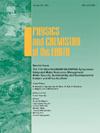Characterization of water-soluble inorganic ions and carbonaceous aerosols in the urban atmosphere in Amman, Jordan
IF 3
3区 地球科学
Q2 GEOSCIENCES, MULTIDISCIPLINARY
引用次数: 0
Abstract
The urban particulate matter (PM) carbonaceous and water-soluble ions were investigated in Amman, Jordan during May 2018–March 2019. The PM2.5 total carbon (TC) annual mean was 7.6 ± 3.6 μg/m3 (organic carbon (OC) 5.9 ± 2.8 μg/m3 and elemental carbon (EC) 1.7 ± 1.1 μg/m3), which was about 16.3% of the PM2.5. The PM10 TC annual mean was 8.4 ± 3.9 μg/m3 (OC 6.5 ± 3.1 μg/m3 and elemental carbon (EC) 1.9 ± 1.1 μg/m3), about 13.3% of the PM10. The PM2.5 total water-soluble ions annual mean was 7.9 ± 1.9 μg/m3 (about 16.9%), and that of the PM10 was 10.1 ± 2.8 μg/m3 (about 16.0%). The minor ions (F−, NO2−, Br−, and PO43−) constituted less than 1% in the PM fractions. The significant fraction was for SO42− (PM2.5 4.7 ± 1.6 μg/m3 (10.0%) and PM10 5.3 ± 1.9 μg/m3 (8.3%)). The NH4+ had higher amounts of PM2.5 (1.3 ± 0.6 μg/m3; 2.7%) than that PM10 (0.9 ± 0.4 μg/m3; 1.4%). During sand and dust storm (SDS) events, TC, Cl−, and NO3− were doubled in PM, SO42− did not increase significantly, and NH4+ slightly decreased. Regression analysis revealed: (1) carbonaceous aerosols come equally from primary and secondary sources, (2) about 50% of the OC came from non-combustion sources, (3) traffic emissions dominate the PM, (4) agricultural sources have a negligible effect, (5) SO42− is completely neutralized by NH4+ in the PM2.5 but there could be additional reactions involved in the PM10, and (6) (NH4)2SO4, was the major species formed by SO42−and NH4+ instead of NH4HSO4. It is recommended to perform long-term sampling and chemical speciation for the urban atmosphere in Jordan.
约旦安曼城市大气中水溶性无机离子和碳质气溶胶的特征
2018年5月至2019年3月期间,对约旦安曼的城市颗粒物(PM)碳质和水溶性离子进行了调查。PM2.5 总碳(TC)年均值为 7.6 ± 3.6 μg/m3(有机碳(OC)5.9 ± 2.8 μg/m3,元素碳(EC)1.7 ± 1.1 μg/m3),约占 PM2.5 的 16.3%。PM10 TC 的年均值为 8.4 ± 3.9 μg/m3(OC 6.5 ± 3.1 μg/m3,元素碳(EC)1.9 ± 1.1 μg/m3),约占 PM10 的 13.3%。PM2.5 的水溶性离子总量年均值为 7.9 ± 1.9 μg/m3(约占 16.9%),PM10 的水溶性离子总量年均值为 10.1 ± 2.8 μg/m3(约占 16.0%)。小离子(F-、NO2-、Br- 和 PO43-)在可吸入颗粒物组分中所占比例不到 1%。重要的是 SO42-(PM2.5 4.7 ± 1.6 μg/m3 (10.0%)和 PM10 5.3 ± 1.9 μg/m3 (8.3%))。NH4+ 在 PM2.5 中的含量(1.3 ± 0.6 μg/m3;2.7%)高于 PM10(0.9 ± 0.4 μg/m3;1.4%)。在沙尘暴(SDS)事件中,可吸入颗粒物中的TC、Cl-和NO3-增加了一倍,SO42-没有显著增加,NH4+略有下降。回归分析表明:(1) 碳质气溶胶同样来自一次源和二次源;(2) 约 50% 的 OC 来自非燃烧源;(3) 交通排放在 PM 中占主导地位;(4) 农业源的影响微乎其微;(5) SO42- 在 PM2.5 中完全被 NH4+ 中和,但在 PM10 中可能还涉及其他反应;(6) (NH4)2SO4 是 SO42 和 NH4+ 形成的主要物种,而不是 NH4HSO4。建议对约旦城市大气进行长期采样和化学分析。
本文章由计算机程序翻译,如有差异,请以英文原文为准。
求助全文
约1分钟内获得全文
求助全文
来源期刊

Physics and Chemistry of the Earth
地学-地球科学综合
CiteScore
5.40
自引率
2.70%
发文量
176
审稿时长
31.6 weeks
期刊介绍:
Physics and Chemistry of the Earth is an international interdisciplinary journal for the rapid publication of collections of refereed communications in separate thematic issues, either stemming from scientific meetings, or, especially compiled for the occasion. There is no restriction on the length of articles published in the journal. Physics and Chemistry of the Earth incorporates the separate Parts A, B and C which existed until the end of 2001.
Please note: the Editors are unable to consider submissions that are not invited or linked to a thematic issue. Please do not submit unsolicited papers.
The journal covers the following subject areas:
-Solid Earth and Geodesy:
(geology, geochemistry, tectonophysics, seismology, volcanology, palaeomagnetism and rock magnetism, electromagnetism and potential fields, marine and environmental geosciences as well as geodesy).
-Hydrology, Oceans and Atmosphere:
(hydrology and water resources research, engineering and management, oceanography and oceanic chemistry, shelf, sea, lake and river sciences, meteorology and atmospheric sciences incl. chemistry as well as climatology and glaciology).
-Solar-Terrestrial and Planetary Science:
(solar, heliospheric and solar-planetary sciences, geology, geophysics and atmospheric sciences of planets, satellites and small bodies as well as cosmochemistry and exobiology).
 求助内容:
求助内容: 应助结果提醒方式:
应助结果提醒方式:


